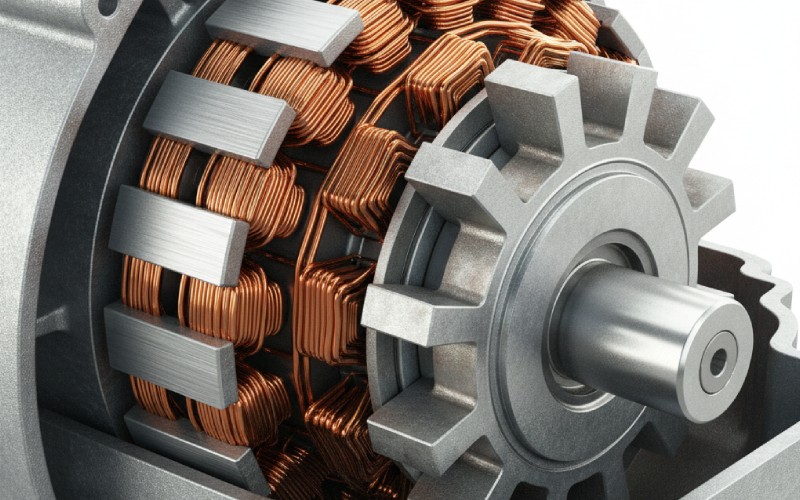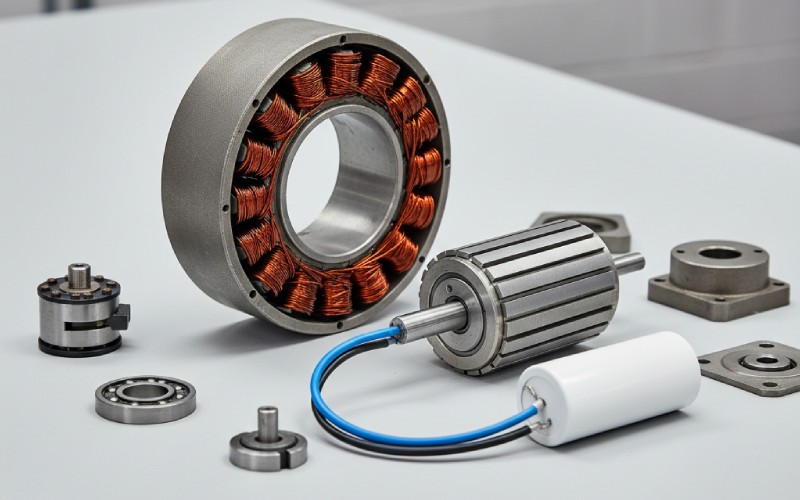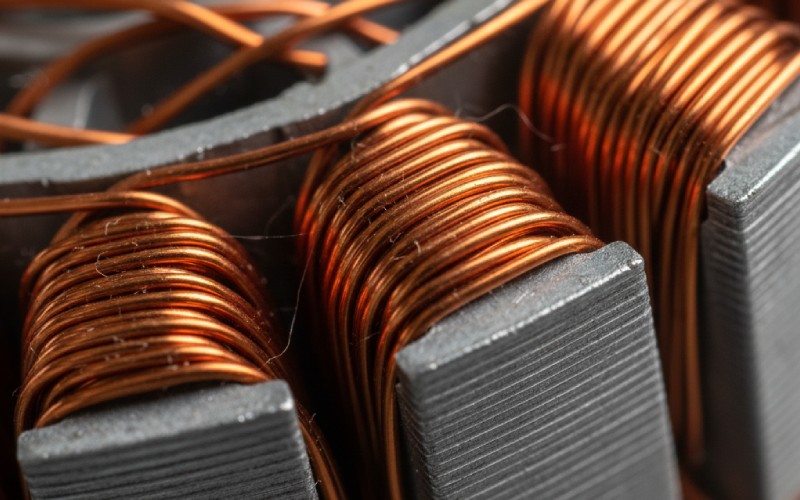Sinoのラミネーションスタックにお任せください!
プロジェクトをスピードアップするために、ラミネーションスタックに以下のような詳細なラベルを付けることができます。 寛容, 材料, 表面仕上げ, 酸化絶縁が必要かどうか, 数量などなど。

扇風機が回ったり、洗濯機が回ったりするのはなぜか、考えたことがあるだろうか。その答えは、単相交流モーターと呼ばれる小さいけれど強力なエンジンです。この記事では、この一般的なモーターがどのように動くのかをわかりやすく説明します。モーターの内部を見て、その部品を確認します。このモーターが始動し、動き続けるのを助ける簡単な秘訣を学びます。この記事を読むと、毎日使っている機械が新しく簡単に理解できます。
単相交流モーターは電気モーターの一種である。単相交流(AC)と呼ばれる種類の電力を使用する。これは、家のコンセントから来る電力と同じ種類のものです。このACモーターは多くの場所で使われている。冷蔵庫の中やエアコンの中、小さな工具の多くにも使われています。モーターの主な目的は、電力を動きに変えることです。この単相モーターは、小さな作業でその仕事を非常にうまくこなします。
このモーターの基本的な考え方は理解しやすい。モーターには2つの大きな部分がある。最初の部品は ステーター.ステーターはモーターの中で動かない部分である。巻線と呼ばれる、円形に巻かれたワイヤーがある。この巻線に交流電流が流れると磁界が発生する。第2の部分は ローター.ローターはモーターの回転部分である。一般的なACモーターの一種である誘導モーターでは、ローターはしばしば「リスケージ」のように見える。このローターにも電流による磁界が発生する。そして2つの磁界が互いに押し引きする。この作用により、ローターは回転、つまり自転する。この回転が機器にパワーを与えるのです。このモーターの動作は、多くの機械にとって非常に重要です。
非常に単純な単相モーターに大きな問題がある。単体で回転を始めることができないのだ。プラグを差し込んでも、ハミングのような音を立てるだけで、じっとしている。これは、交流電力が磁界を作り、それがただ一点を押したり引いたり往復するだけだからだ。ブランコを押すようなものだ。ブランコの真ん前に立って、前に押して、後ろに引くだけでは、ブランコはどこにも行きません。この基本モーターの磁場は、ローターに対して同じことをする。押したり引いたりはするが、ローターを回転させることはない。
ローターを回転させるためには、モーターは前後に押すだけの磁場ではなく、回転する磁場を必要とする。三相モーターは問題なく回転磁界を作ることができるが、単相モーターはそうはいかない。このモーターでは、1本の固定子巻線が作る磁場が強くなったり弱くなったりするだけだ。磁界はモーター内を動き回ることはない。磁界が回転しないので、ローターが回転を始めるのに必要な最初の一押しを与えることができない。このため、この種のモーターは始動に何らかの手助けが必要である。さまざまな種類の単相モーターはすべて、モーターに最初の一押しを与えるための巧妙な方法にすぎない。
スプリットフェーズ・モーターは、単相誘導モーターの賢い一種です。簡単なトリックで始動時の問題を解決する。このモーターは、ステーターに1つだけでなく2つの巻線を持っている。1つ目は主巻線。もう1つは主巻線と呼ばれる余分な巻線である。 補助巻線 または始動巻線。この補助巻線がモーターの始動を助ける秘訣です。補助巻線は主巻線とは異なる構造になっています。補助巻線はループの少ない細いワイヤーを使用しています。そのため、抵抗値が高くなります。
モーターのスイッチを入れると、電流が両方の巻線に流れます。補助巻線は異なるため、そこを流れる電流は主巻線の電流と同期しません。この違いによって磁界が発生し回転しますが、あまり強くはありません。完全な回転磁場ではないが、ローターが回転を始めるには十分な強さである。ブランコを正面からではなく横から押すようなものだ。この最初の一押しが、モーターに必要なすべてなのだ。
モーターが最高速度の約75%まで上がると、"A "と呼ばれる特別なスイッチが作動する。 遠心スイッチ が開きます。このスイッチはローターにある。ローターが速く回転すると、小さな重りが飛び出し、スイッチが開く。これにより補助巻線への電力が遮断される。この時点で、モーターは主巻線のみを使って回転します。ローターの回転がモーターの回転を維持するので、モーターは補助巻線を必要としなくなる。このスプリット・フェーズ・モーター設計は、自分で始動できるモーターを安価に作る方法である。

単相モーターにはいくつかの種類がある。モーターの種類によって始動方法やセットアップが異なります。ある作業に適したモーターは、そのモーターに何をさせるかによって決まります。始動時に力強く押し出すモーターもあれば、騒音をあまり出さずに無駄な力を使わずに運転するのに適したモーターもあります。これらの種類を知ることで、作業に適したモーターを選ぶことができます。
ここでは、単相モーターの主な種類について説明する:
これらのモーターの最大の違いは、2相目の電流の作り方にある。この第2相は回転磁界を作るために必要である。スプリット・フェーズ・モーターは、補助巻線に異なる種類のワイヤーを使うことでこれを実現している。コンデンサー・モーターは、コンデンサーを使用して電流をより同期しないようにする。隈取磁極モーターは、極に特殊な銅リングを使用する。
コンデンサ・スタート・モーターは、単純な分割相モーターから大きくステップアップしたものである。このモーターはコンデンサ・モーターの一種である。スプリット・フェーズ・モーターと同様に、主巻線と遠心スイッチ付きの補助巻線がある。大きな違いは コンデンサ は補助巻線とライン接続されている。コンデンサーは、エネルギーを蓄え、放出することができる電気部品である。このモーターでは、コンデンサーによって補助巻線に流れる電流がより同期しなくなる。これにより、モーターは始動時に二相モーターのように動作する。
この電流の大きな差が、より強い回転磁界を作る。その結果、始動トルクが大幅に向上する。始動トルクとは、モーターが始動するときに、ねじれる力の大きさのことです。始動トルクの高いモーターは、重負荷がかかっても始動できる。このため、コンデンサスタート・モータは、エアコンプレッサや大型ポンプのような、動かすのが難しい機械に最適です。
モーターが最高速度の約75%に達すると、遠心スイッチが開く。補助巻線とコンデンサーの両方がオフになる。その後、モーターは主巻線のみを使って作動する。このモーターは、一度動き出すと多くのエネルギーを節約する方法で作動する。コンデンサーは始動時に短時間使用されるだけなので、あまりコストのかからない小さな部品で済む。このモーターの最大の長所は、始動力が大きいことだ。
永久分割コンデンサ(PSC)モータもコンデンサモータの一種です。その名前が、何が特別なのかを正確に物語っている。コンデンサは常に回路に接続されている。このモーターには、補助巻線やコンデンサをオフにする遠心スイッチはありません。主巻線とコンデンサ付き補助巻線の両方が、モーターがオンになっている間ずっと働いているのです。
コンデンサーは常に使用されているため、異なるタイプのコンデンサーを選ばなければならない。一瞬だけでなく、常に動くようにする必要がある。この種のモーターは、コンデンサー・スタート・モーターのような強い始動力を持たない。実際、始動時の押し出しはかなり弱い。しかし、このモーターには他にも良い点がある。とても静かで、スムーズに動く。また、スプリットフェーズ・モーターよりも電力の無駄が少ない。
永久分割コンデンサ・モーターは、ご家庭の冷暖房システムのようなファンや送風機でよく見かけます。このような仕事では、強力な始動力は必要ありません。静かで省電力のモーターの方が重要です。このモーターの回転数は、電圧を調整することで簡単に変えることもできる。このため、さまざまな速度レベルを必要とするファンには良い選択となる。このモーターは、コストと性能のバランスが取れている。
そう、先ほど説明した2つのコンデンサ・モータの良いところを組み合わせれば、モーターはさらに良く動く。このモーターはコンデンサスタート、コンデンサランモーターと呼ばれる。単相モーターとしては最高のものですが、最もコストがかかるものでもあります。このモーターは2つのコンデンサを使い、始動時とフル回転時に最高の働きをします。
このモーターのセットアップには2つのコンデンサーがある。一つは大きな値の始動用コンデンサーである。コンデンサ・スタート・モーターと同じように、補助巻線と一列に接続されている。これによってモーターは非常に強力に始動し、重いものを動かすことができる。2つ目のコンデンサもあり、これは値の小さいランコンデンサです。この永久コンデンサは、モーターが運転している間、補助巻線に接続されたままです。
仕組みはこうだ:モーターが動き始めると、両方のコンデンサーが回路に入る。両コンデンサはチームとして働き、非常に強力な回転磁界と非常に高い始動トルクを作る。モーターがスピードアップすると、遠心スイッチが始動コンデンサーをオフにする。モーターは主巻線と補助巻線で動き続け、補助巻線にはまだ走行用コンデンサーが残っている。このセットアップにより、モーターは非常にスムーズに、静かに、無駄な電力を消費することなく作動します。このモーターは、強力な始動性と優れた走行性という、すべての長所を備えています。
隈取磁極モーターは、単相モーターの中で最もシンプルでコストのかからない種類である。非常に単純な方法で作られている。このモーターは固定子に極があり、それぞれの極の一部が銅のリングで巻かれている。このリングは遮光コイルと呼ばれる。これがこのモーターの名前の由来です。隈取磁極モーターには補助巻線もコンデンサーもない。これは全く異なる種類のモーターである。
どのように走るかの考え方はこうだ。ステーター巻線に交流電流が流れると、それが作る磁場が変化し始める。遮光コイルはこの変化に抗して押す。この作用により、磁極の「遮光された」部分の磁場は、主要部分の磁場より少し遅れる。この遅れによって、非常に弱い回転磁界が作られる。磁場は、ポールの陰になっていない部分から陰になっている部分に移動しているように見えます。これは、ローターが回転し始めるのに十分な程度である。
スピニング・フィールドが非常に弱いため、このモーターは始動時の押し出しが非常に弱い。始動が簡単な小さな作業にしか使えない。また、隈取磁極モーターは多くの電力を浪費する。しかし、非常に安価に作ることができ、頼りになり、シンプルである。このモーターは、小型ファンや水槽用ポンプなど、低価格が最も重要な要素であり、モーターの低電力は問題ではない小物で目にすることができます。これは非常に人気のある小型ACモーターです。

適切な単相モーターを選ぶには、それらがどのように違うかを見る必要がある。モーターの種類によって、適しているものが異なる。主に見るべき点は、始動時の押しの強さ、価格、どれだけ電力を節約できるか、モーターの静粛性です。単純な表は、モーター設計の違いを見るのに役立ちます。この比較によって、あるモーターが大きな機械に使われ、別のモーターが小さなファンに使われる理由がわかります。
以下は、主な単相モーターの種類を比較するのに役立つ表です:
| モータータイプ | スタートプッシュ | 価格 | 省電力 | 一般的な使用 |
|---|---|---|---|---|
| スプリットフェーズ・モーター | 低い | 低い | ミディアム | 小型工具、扇風機、送風機 |
| コンデンサ・スタート・モーター | 高い | ミディアム | 高い | コンプレッサー、ポンプ、大型機械 |
| 永久分割コンデンサモーター | 低い | ミディアム | 高い | ファン、ブロワー(HVACシステム) |
| コンデンサスタート、コンデンサランモータ | 非常に高い | 高い | 非常に高い | 木工機械、大型設備 |
| 隈取磁極モーター | 非常に低い | 非常に低い | 低い | 小型扇風機、小型ポンプ、おもちゃ |
お分かりのように、モーターを選ぶということは、あるものを諦めて別のものを手に入れるという選択なのです。大変な仕事のために強力な始動力を持つモーターが必要な場合は、コンデンサ・モーターに高いお金を払う必要があります。ファン用の小型で安価なモーターが必要なだけなら、隈取磁極モーターが非常に良い選択です。各モーターのこの特別な性質を理解することは非常に重要です。
単相モーターを選ぶ最良の方法は、それを必要とする仕事によって完全に異なります。モーターが何をしなければならないかを考えなければなりません。いくつかの重要な質問を自問自答する必要があります。まず、モーターにはどれくらいの始動力が必要か。コンプレッサーのピストンのように重いものを始動させるのであれば、高い始動トルクが必要です。コンデンサ・スタート・モータが賢い選択でしょう。
次に、モーターにいくらかけられるか。価格はしばしば考えるべき重要な事柄である。完璧に動作することが最も重要ではない単純な機械には、分割相モーターや隈取磁極モーターのような低コストのモーターが最良の選択かもしれません。第三に、省電力で静かであることがどれほど重要か。エアコンのように毎日何時間も稼働するモーターには、永久分割コンデンサモーターのような省電力モーターが電気代の節約になります。また、静かなモーターは、家庭で使うにはより快適です。
最後に、必要なサイズとパワーについて考えましょう。モーターの馬力は、動力源となる機械に適したものでなければなりません。また、モーターが必要とする電圧と電流が、お使いの電気系統に適合していることも確認する必要があります。始動性、価格、省電力性、必要な電力など、これらのポイントをそれぞれ考えることで、どのような作業にも最適な単相モーターを選ぶことができます。適切なモーターは、その仕事をうまくこなし、何年も長持ちします。